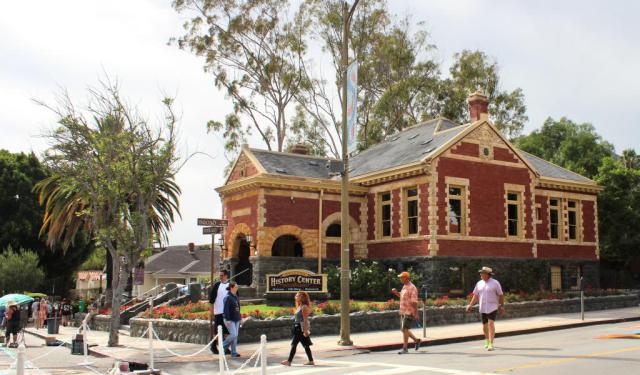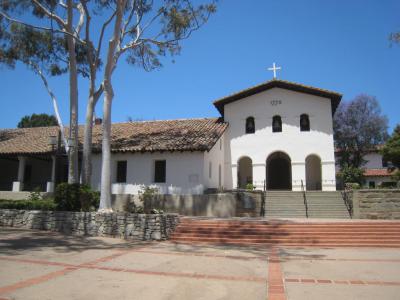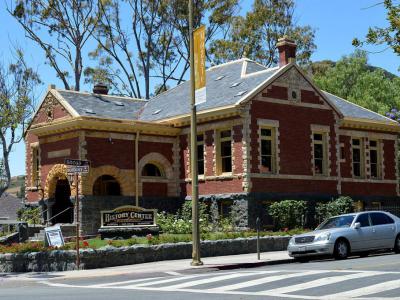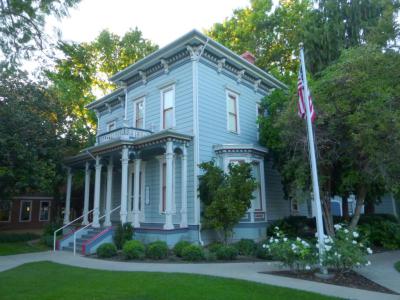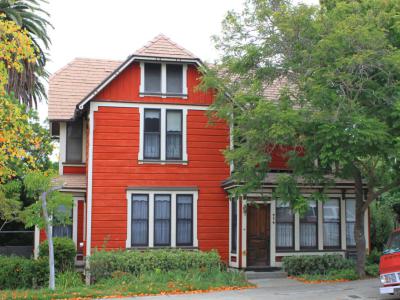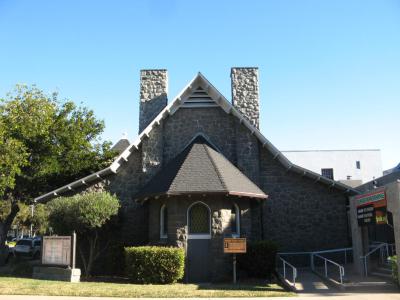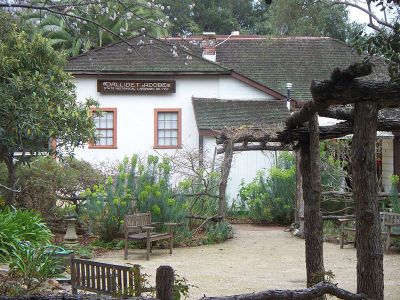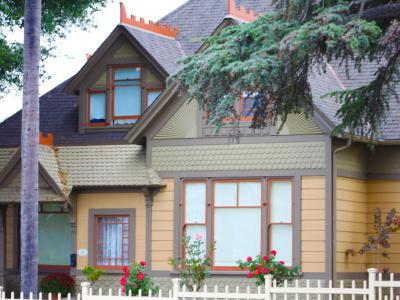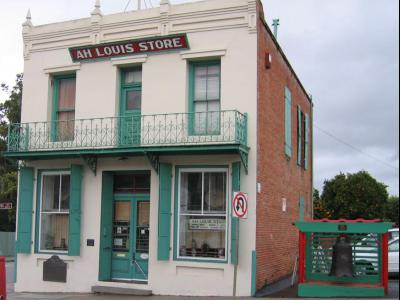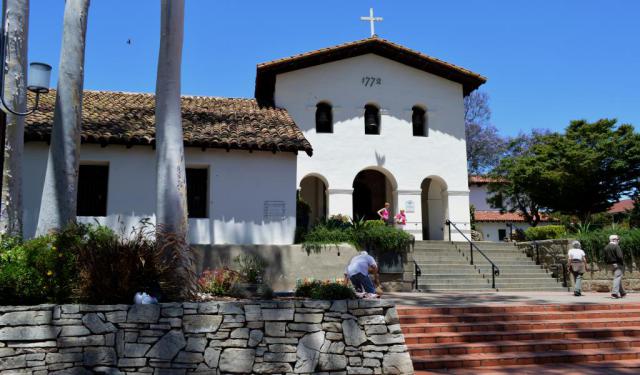San Luis Obispo Historical Buildings Walk (Self Guided), San Luis Obispo
Architecture – the thoughtful making of space. One of the timeless values of historical buildings is that they continue to shape people long after the people shaped them originally. In the context of San Luis Obispo's historic architecture, it reminds us of the thoughtful design and craftsmanship that went into creating the buildings that still stand as symbols of the city's enduring legacy, blending tradition and innovation with every brick and beam.
Over two and a half centuries have passed since San Luis Obispo was founded, in 1772, by the Spanish missionary Junipero Serra. These years have created a vast number of historic sites, stories, and city secrets that travelers and locals just cannot miss! Sometimes, a stroll through San Luis Obispo seems like stepping into a painting, where every street is a stroke of artistry.
The Mission San Luis Obispo de Tolosa is the central historical landmark in the city. Its church, constructed in 1793, is a beautiful example of Spanish colonial architecture.
The Robert Jack House, built in 1878, is a prime example of Italianate style, providing insights into the lifestyle and history of the region. Much like it is the Myron Angel House, another notable Victorian-era building. It showcases elements of the Eastlake and Stick styles, featuring decorative woodwork, gables, and a prominent tower.
The First Presbyterian Church is an iconic landmark of the English Arts and Crafts movement.
Among other highlights worthy of note you will find the 19th-century Dallidet Adobe, displaying artifacts from the region's winemaking history, and the William Shipsey House, an excellent piece of Queen Anne style.
Finally, Ah Louis Store, is notable for being the first general store and “social hub” of the kind for the local Chinese community.
If you're looking for a glimpse into history as you walk through the area, San Luis Obispo has a wealth of landmarks and intriguing stories of the past that are sure to capture your interest. To turn the pages of this living history book, take our self-guided tour.
Over two and a half centuries have passed since San Luis Obispo was founded, in 1772, by the Spanish missionary Junipero Serra. These years have created a vast number of historic sites, stories, and city secrets that travelers and locals just cannot miss! Sometimes, a stroll through San Luis Obispo seems like stepping into a painting, where every street is a stroke of artistry.
The Mission San Luis Obispo de Tolosa is the central historical landmark in the city. Its church, constructed in 1793, is a beautiful example of Spanish colonial architecture.
The Robert Jack House, built in 1878, is a prime example of Italianate style, providing insights into the lifestyle and history of the region. Much like it is the Myron Angel House, another notable Victorian-era building. It showcases elements of the Eastlake and Stick styles, featuring decorative woodwork, gables, and a prominent tower.
The First Presbyterian Church is an iconic landmark of the English Arts and Crafts movement.
Among other highlights worthy of note you will find the 19th-century Dallidet Adobe, displaying artifacts from the region's winemaking history, and the William Shipsey House, an excellent piece of Queen Anne style.
Finally, Ah Louis Store, is notable for being the first general store and “social hub” of the kind for the local Chinese community.
If you're looking for a glimpse into history as you walk through the area, San Luis Obispo has a wealth of landmarks and intriguing stories of the past that are sure to capture your interest. To turn the pages of this living history book, take our self-guided tour.
How it works: Download the app "GPSmyCity: Walks in 1K+ Cities" from Apple App Store or Google Play Store to your mobile phone or tablet. The app turns your mobile device into a personal tour guide and its built-in GPS navigation functions guide you from one tour stop to next. The app works offline, so no data plan is needed when traveling abroad.
San Luis Obispo Historical Buildings Walk Map
Guide Name: San Luis Obispo Historical Buildings Walk
Guide Location: USA » San Luis Obispo (See other walking tours in San Luis Obispo)
Guide Type: Self-guided Walking Tour (Sightseeing)
# of Attractions: 8
Tour Duration: 2 Hour(s)
Travel Distance: 3.9 Km or 2.4 Miles
Author: sabrina
Sight(s) Featured in This Guide:
Guide Location: USA » San Luis Obispo (See other walking tours in San Luis Obispo)
Guide Type: Self-guided Walking Tour (Sightseeing)
# of Attractions: 8
Tour Duration: 2 Hour(s)
Travel Distance: 3.9 Km or 2.4 Miles
Author: sabrina
Sight(s) Featured in This Guide:
- Mission San Luis Obispo de Tolosa
- Carnegie Library
- Robert Jack House
- Myron Angel House
- First Presbyterian Church
- Dallidet Adobe and Gardens
- William Shipsey House
- Ah Louis Store
1) Mission San Luis Obispo de Tolosa (must see)
Old Mission San Luis Obispo de Tolosa holds a significant place in the history of Central California. Established on September 1st, 1772, by Father Junipero Serra, it is the fifth mission in the chain and is named after Saint Louis, Bishop of Toulouse.
The mission's founding followed an expedition where the explorers stumbled upon the Valley of the Bears, known as La Cañada de Los Osos. When food supplies were scarce at the existing missions in California, an expedition was sent to hunt for meat in the valley. The local Indians, grateful for the soldiers' assistance in eliminating bears, traded edible seeds in return for the meat. Father Serra recognized the potential of the region and decided it would be an ideal location for the fifth mission. While the city of San Luis Obispo has since evolved and is no longer a bear-inhabited territory, a statue of a grizzly bear in the mission plaza serves as a reminder of its earlier days.
In 1776, a devastating fire broke out at the mission when an Indian fired a flaming arrow onto one of the mission buildings. This event prompted the fathers to start producing roof tiles locally to reduce the risk of future fires. Over time, the mission underwent modernization and adaptation to changing needs. For example, what was once the fathers' soup kitchen now serves as a youth center.
Remarkably, Old Mission San Luis Obispo has remained on its original site and has never had to relocate. The mission's walls, reaching heights of 50 to 60 feet, were constructed according to Vatican law, which required churches to be as tall as the local trees-in this case, the pine trees. The mission's unique architecture features a long secondary nave that forms an L-shaped church, making it the only mission in California with this distinctive layout.
The mission's founding followed an expedition where the explorers stumbled upon the Valley of the Bears, known as La Cañada de Los Osos. When food supplies were scarce at the existing missions in California, an expedition was sent to hunt for meat in the valley. The local Indians, grateful for the soldiers' assistance in eliminating bears, traded edible seeds in return for the meat. Father Serra recognized the potential of the region and decided it would be an ideal location for the fifth mission. While the city of San Luis Obispo has since evolved and is no longer a bear-inhabited territory, a statue of a grizzly bear in the mission plaza serves as a reminder of its earlier days.
In 1776, a devastating fire broke out at the mission when an Indian fired a flaming arrow onto one of the mission buildings. This event prompted the fathers to start producing roof tiles locally to reduce the risk of future fires. Over time, the mission underwent modernization and adaptation to changing needs. For example, what was once the fathers' soup kitchen now serves as a youth center.
Remarkably, Old Mission San Luis Obispo has remained on its original site and has never had to relocate. The mission's walls, reaching heights of 50 to 60 feet, were constructed according to Vatican law, which required churches to be as tall as the local trees-in this case, the pine trees. The mission's unique architecture features a long secondary nave that forms an L-shaped church, making it the only mission in California with this distinctive layout.
2) Carnegie Library
The San Luis Obispo Carnegie Library is a remarkable example of a Carnegie library. Constructed in 1905 with funding from the Carnegie Foundation, the library served as the city's subscription library program, which had been in operation since 1894.
Renowned architect William H. Weeks, who designed 21 Carnegie libraries in California, crafted the design of the San Luis Obispo library in the distinctive Richardsonian Romanesque style. The library's architectural features include a tall hipped roof with two gabled wings, decorative elements such as gargoyles adorning the gable ends, and an entrance portico adorned with multiple round arches. The building's façade primarily consists of red brick with yellow sandstone trim, while the basement showcases a dark gray granite exterior.
Operating as a library until 1955, the building transitioned into a county historical museum the following year. Today, the library building is listed on the National Register of Historic Places, recognized for its architectural significance and its role in the community's history.
Currently, the Carnegie Library houses the History Center of San Luis Obispo County, formerly known as the San Luis Obispo County Historical Museum. The museum offers visitors a glimpse into the region's rich history and culture through changing exhibits. Additionally, it provides a research room for individuals interested in exploring the area's past.
Renowned architect William H. Weeks, who designed 21 Carnegie libraries in California, crafted the design of the San Luis Obispo library in the distinctive Richardsonian Romanesque style. The library's architectural features include a tall hipped roof with two gabled wings, decorative elements such as gargoyles adorning the gable ends, and an entrance portico adorned with multiple round arches. The building's façade primarily consists of red brick with yellow sandstone trim, while the basement showcases a dark gray granite exterior.
Operating as a library until 1955, the building transitioned into a county historical museum the following year. Today, the library building is listed on the National Register of Historic Places, recognized for its architectural significance and its role in the community's history.
Currently, the Carnegie Library houses the History Center of San Luis Obispo County, formerly known as the San Luis Obispo County Historical Museum. The museum offers visitors a glimpse into the region's rich history and culture through changing exhibits. Additionally, it provides a research room for individuals interested in exploring the area's past.
3) Robert Jack House
The Robert Jack House is a remarkable two-story Italianate-style historic house that holds both architectural and historical significance. It was added to the National Register of Historic Places in 1992, with the listing including two contributing buildings.
The Jack House, currently under the ownership of the City of San Luis Obispo, stands as a testament to the city's rich past. Volunteer docents provide guided tours of the house on Sundays from April through November, allowing visitors to immerse themselves in its historical charm. Additionally, the house opens its doors for holiday celebrations and special events.
The construction of the house was attributed to Robert Edgar Jack, a prominent figure in the community. Jack, who was a respected banker, land developer, and wool grower in Central California, made the house his home from 1882 until his passing in 1916. His significant contributions to the region, both in the financial sector and as a land developer, played a pivotal role in the growth and development of the area.
Robert Jack's involvement in promoting the construction of the railroad through the central coast further highlights his influence and vision for the community. As a leading citizen, he recognized the economic benefits that the railroad would bring to the region, and his support contributed to its successful establishment.
Architecturally, the Robert Jack House holds significance as an excellent example of Italianate architecture. The house showcases characteristic features of the style, reflecting the elegance and craftsmanship of the era in which it was built. Its distinctive design and attention to detail contribute to its architectural appeal.
Editor's note: Robert Jack House is temporarily closed.
The Jack House, currently under the ownership of the City of San Luis Obispo, stands as a testament to the city's rich past. Volunteer docents provide guided tours of the house on Sundays from April through November, allowing visitors to immerse themselves in its historical charm. Additionally, the house opens its doors for holiday celebrations and special events.
The construction of the house was attributed to Robert Edgar Jack, a prominent figure in the community. Jack, who was a respected banker, land developer, and wool grower in Central California, made the house his home from 1882 until his passing in 1916. His significant contributions to the region, both in the financial sector and as a land developer, played a pivotal role in the growth and development of the area.
Robert Jack's involvement in promoting the construction of the railroad through the central coast further highlights his influence and vision for the community. As a leading citizen, he recognized the economic benefits that the railroad would bring to the region, and his support contributed to its successful establishment.
Architecturally, the Robert Jack House holds significance as an excellent example of Italianate architecture. The house showcases characteristic features of the style, reflecting the elegance and craftsmanship of the era in which it was built. Its distinctive design and attention to detail contribute to its architectural appeal.
Editor's note: Robert Jack House is temporarily closed.
4) Myron Angel House
The Myron Angel House is a historic residence that holds significant architectural and historical value. Constructed around 1880, the house exhibits a vernacular design, reflecting a unique blend of architectural elements rather than adhering to a specific style.
This two-story wood-frame house boasts redwood siding and a shingled gable roof, lending it a charming and rustic appearance. Notably, the window surrounds and gable ends feature intricate Eastlake details, adding a touch of elegance to the overall design.
The historical significance of the Myron Angel House stems from its former resident, Myron Angel himself. Myron Angel was a prominent figure in the establishment of California Polytechnic State University, widely known as Cal Poly. He resided in the house from 1889 until his passing in 1911. Angel played a crucial role in proposing and advocating for the creation of a polytechnic school in California. His tireless efforts and passionate campaign were instrumental in the founding of Cal Poly in San Luis Obispo.
Beyond his educational activism, Myron Angel was an influential journalist and historian. His contributions to the field of journalism and his dedication to preserving historical knowledge further solidify his legacy. The Myron Angel House stands as a testament to his vision and accomplishments, serving as a tangible reminder of his pivotal role in shaping the educational landscape of California.
Due to its architectural and historical significance, the Myron Angel House was added to the National Register of Historic Places on November 22, 1982. This recognition highlights the house's cultural importance and ensures its preservation for future generations to appreciate.
This two-story wood-frame house boasts redwood siding and a shingled gable roof, lending it a charming and rustic appearance. Notably, the window surrounds and gable ends feature intricate Eastlake details, adding a touch of elegance to the overall design.
The historical significance of the Myron Angel House stems from its former resident, Myron Angel himself. Myron Angel was a prominent figure in the establishment of California Polytechnic State University, widely known as Cal Poly. He resided in the house from 1889 until his passing in 1911. Angel played a crucial role in proposing and advocating for the creation of a polytechnic school in California. His tireless efforts and passionate campaign were instrumental in the founding of Cal Poly in San Luis Obispo.
Beyond his educational activism, Myron Angel was an influential journalist and historian. His contributions to the field of journalism and his dedication to preserving historical knowledge further solidify his legacy. The Myron Angel House stands as a testament to his vision and accomplishments, serving as a tangible reminder of his pivotal role in shaping the educational landscape of California.
Due to its architectural and historical significance, the Myron Angel House was added to the National Register of Historic Places on November 22, 1982. This recognition highlights the house's cultural importance and ensures its preservation for future generations to appreciate.
5) First Presbyterian Church
First Presbyterian Church holds a rich history that dates back to its founding in 1875. The church was established by McDowell Reid Venable, a Civil War veteran and San Luis Obispo county judge, along with eleven charter members. It became the third Protestant church in the area.
Initially, the church operated from a small wooden building located at the corner of Marsh and Morro Streets. In 1884, this modest structure was replaced by a larger Victorian Stick-Eastlake church, capable of accommodating around 200 people. However, in 1904, the church building was moved to the adjacent lot, where it continued to serve the congregation and the community for the next two decades.
In 1904, the cornerstone for the present-day church building was laid. Constructed in 1905, the church stands as a testament to the English Arts and Crafts style and is made of granite quarried from the nearby Bishop Peak. The church's architecture showcases the meticulous craftsmanship of the era.
Over the years, additional structures have been added to the church grounds. In February 1929, the Educational Unit was constructed and dedicated to further support the church's educational programs. The A. G. Wilson Fellowship Hall, built in 1987, serves as a central hub for church fellowship activities and community events.
In 2001, the stone sanctuary underwent earthquake retrofitting to ensure its structural integrity. Furthermore, in the spring of 2008, the City of San Luis Obispo approved the construction of a Housing Project to complement the ministry of Front Porch. This expansion includes approximately 40 rooms, a ministry hall, a cafe, a kitchen, and a residence for the director and their family, aiming to enhance the church's ability to serve the community.
Initially, the church operated from a small wooden building located at the corner of Marsh and Morro Streets. In 1884, this modest structure was replaced by a larger Victorian Stick-Eastlake church, capable of accommodating around 200 people. However, in 1904, the church building was moved to the adjacent lot, where it continued to serve the congregation and the community for the next two decades.
In 1904, the cornerstone for the present-day church building was laid. Constructed in 1905, the church stands as a testament to the English Arts and Crafts style and is made of granite quarried from the nearby Bishop Peak. The church's architecture showcases the meticulous craftsmanship of the era.
Over the years, additional structures have been added to the church grounds. In February 1929, the Educational Unit was constructed and dedicated to further support the church's educational programs. The A. G. Wilson Fellowship Hall, built in 1987, serves as a central hub for church fellowship activities and community events.
In 2001, the stone sanctuary underwent earthquake retrofitting to ensure its structural integrity. Furthermore, in the spring of 2008, the City of San Luis Obispo approved the construction of a Housing Project to complement the ministry of Front Porch. This expansion includes approximately 40 rooms, a ministry hall, a cafe, a kitchen, and a residence for the director and their family, aiming to enhance the church's ability to serve the community.
6) Dallidet Adobe and Gardens
The Dallidet Adobe and Gardens is a site of historical significance and natural beauty. Originally owned by Pierre Hypolite Dallidet, who arrived in San Francisco in 1850 during the gold rush, the adobe and its surrounding gardens have a rich history.
In 1856, Pierre Dallidet established his home in the adobe, along with his wife Maria Ascension Salazar and their seven children. Pierre played a significant role in the region as the first commercial vintner, contributing to the area's burgeoning wine industry. The adobe served as a residence for the Dallidet family and witnessed the growth of San Luis Obispo.
In 1953, Paul Dallidet, the youngest son of Pierre and Ascención, entrusted the adobe to the San Luis Obispo County Historical Society, desiring to preserve his family's legacy. It was a meaningful gesture, as it marked exactly 100 years since Pierre Dallidet's arrival in San Luis Obispo. Paul lived in the adobe until his passing in February 1958, shortly before his 87th birthday.
Today, the Dallidet Adobe and Gardens, owned and operated by the History Center of SLO County, welcomes visitors for educational tours, events, and even weddings. The site has been designated as a California Historical Landmark (#720), acknowledging its historical significance and preservation efforts.
The adobe itself offers a glimpse into the past, allowing visitors to explore the architecture and interiors that reflect the lifestyle of the Dallidet family. Additionally, the surrounding gardens provide a serene and picturesque setting, with carefully manicured landscapes, vibrant flora, and charming walkways.
In 1856, Pierre Dallidet established his home in the adobe, along with his wife Maria Ascension Salazar and their seven children. Pierre played a significant role in the region as the first commercial vintner, contributing to the area's burgeoning wine industry. The adobe served as a residence for the Dallidet family and witnessed the growth of San Luis Obispo.
In 1953, Paul Dallidet, the youngest son of Pierre and Ascención, entrusted the adobe to the San Luis Obispo County Historical Society, desiring to preserve his family's legacy. It was a meaningful gesture, as it marked exactly 100 years since Pierre Dallidet's arrival in San Luis Obispo. Paul lived in the adobe until his passing in February 1958, shortly before his 87th birthday.
Today, the Dallidet Adobe and Gardens, owned and operated by the History Center of SLO County, welcomes visitors for educational tours, events, and even weddings. The site has been designated as a California Historical Landmark (#720), acknowledging its historical significance and preservation efforts.
The adobe itself offers a glimpse into the past, allowing visitors to explore the architecture and interiors that reflect the lifestyle of the Dallidet family. Additionally, the surrounding gardens provide a serene and picturesque setting, with carefully manicured landscapes, vibrant flora, and charming walkways.
7) William Shipsey House
The William Shipsey House is a remarkable historical residence that holds a prominent place on the National Register of Historic Places. Designed by architect Hilamon Spencer Laird, the house is characterized by a unique blend of architectural styles, combining elements of Queen Anne and Stick/Eastlake design.
Constructed in 1894, the William Shipsey House stands as a testament to the architectural craftsmanship and local design of its time. The house's historical significance lies in its association with William Shipsey, the individual for whom it was built. Shipsey's role in the community and his connection to the property contribute to its historical value.
The house exemplifies the architectural trends prevalent during the late 19th century. The combination of Queen Anne and Stick/Eastlake elements showcases the intricate detailing, ornamental woodwork, and decorative features that define these architectural styles. Its design and craftsmanship reflect the skilled work of the period, making it a noteworthy example of local architecture.
As an outstanding representation of local design and craftsmanship, the William Shipsey House provides insight into the architectural heritage of San Luis Obispo. Its inclusion on the National Register of Historic Places highlights its historical and cultural significance, ensuring its preservation for future generations to appreciate.
Constructed in 1894, the William Shipsey House stands as a testament to the architectural craftsmanship and local design of its time. The house's historical significance lies in its association with William Shipsey, the individual for whom it was built. Shipsey's role in the community and his connection to the property contribute to its historical value.
The house exemplifies the architectural trends prevalent during the late 19th century. The combination of Queen Anne and Stick/Eastlake elements showcases the intricate detailing, ornamental woodwork, and decorative features that define these architectural styles. Its design and craftsmanship reflect the skilled work of the period, making it a noteworthy example of local architecture.
As an outstanding representation of local design and craftsmanship, the William Shipsey House provides insight into the architectural heritage of San Luis Obispo. Its inclusion on the National Register of Historic Places highlights its historical and cultural significance, ensuring its preservation for future generations to appreciate.
8) Ah Louis Store
The Ah Louis Store is a historic landmark that holds significant cultural and historical importance. Owned by Wong, more commonly known as Ah Louis, the store played a vital role in the development of the Central Coast of California during the late 19th and early 20th centuries.
Ah Louis was a prominent Chinese American figure in San Luis Obispo. He held various roles as a banker, labor contractor, farmer, and shopkeeper, leaving a lasting impact on the community. His contributions to the region include organizing Chinese laborers during the construction of the Pacific Coast Railway's Avila-Port Harford spur and the tunnels through Cuesta Grade over the Santa Lucia Range. Ah Louis was instrumental in the growth and progress of the area.
Recognizing the needs of the local Chinese community, Ah Louis opened the first East Asian mercantile in San Luis Obispo County in 1874. The store provided a range of goods, including rice, rum, and opium (opium use was legal until 1915). The original wooden structure was later replaced with a sturdy brick building in 1885, constructed from bricks sourced from Ah Louis's own brickyard. Located at 800 Palm Street on the corner of Chorro Street in downtown San Luis Obispo, the building stands as a reminder of the city's historic Chinatown.
Today, the Ah Louis Store is owned by William Watson, Ah Louis's great-grandson. The ground floor of the building operates as a retail store, offering visitors a glimpse into the past while providing a unique shopping experience. The store's historical significance is recognized at both the state and national levels. It has been designated as California State Historical Landmark number 802 and is listed on the National Register of Historic Places.
Ah Louis was a prominent Chinese American figure in San Luis Obispo. He held various roles as a banker, labor contractor, farmer, and shopkeeper, leaving a lasting impact on the community. His contributions to the region include organizing Chinese laborers during the construction of the Pacific Coast Railway's Avila-Port Harford spur and the tunnels through Cuesta Grade over the Santa Lucia Range. Ah Louis was instrumental in the growth and progress of the area.
Recognizing the needs of the local Chinese community, Ah Louis opened the first East Asian mercantile in San Luis Obispo County in 1874. The store provided a range of goods, including rice, rum, and opium (opium use was legal until 1915). The original wooden structure was later replaced with a sturdy brick building in 1885, constructed from bricks sourced from Ah Louis's own brickyard. Located at 800 Palm Street on the corner of Chorro Street in downtown San Luis Obispo, the building stands as a reminder of the city's historic Chinatown.
Today, the Ah Louis Store is owned by William Watson, Ah Louis's great-grandson. The ground floor of the building operates as a retail store, offering visitors a glimpse into the past while providing a unique shopping experience. The store's historical significance is recognized at both the state and national levels. It has been designated as California State Historical Landmark number 802 and is listed on the National Register of Historic Places.
Walking Tours in San Luis Obispo, California
Create Your Own Walk in San Luis Obispo
Creating your own self-guided walk in San Luis Obispo is easy and fun. Choose the city attractions that you want to see and a walk route map will be created just for you. You can even set your hotel as the start point of the walk.
San Luis Obispo Introduction Walking Tour
San Luis Obispo, or SLO for short, is a lovely Californian city with a strong Spanish heritage. Situated in the heart of the state's central coast, this hidden gem is known for its ability to “captivate the soul with its allure of beautiful natural setting, vibrant downtown area, and cultural scene.”
The region's history dates back thousands of years to the Chumash Native American... view more
Tour Duration: 1 Hour(s)
Travel Distance: 0.9 Km or 0.6 Miles
The region's history dates back thousands of years to the Chumash Native American... view more
Tour Duration: 1 Hour(s)
Travel Distance: 0.9 Km or 0.6 Miles
The Most Popular Cities
/ view all
